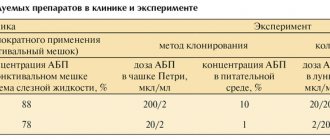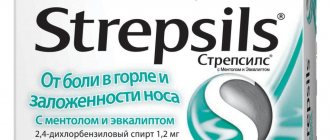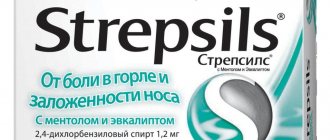Azithromycin: indications for use and contraindications
The manufacturer's instructions for the drug indicate the following pathologies for which the drug is sufficiently effective:
- inflammatory processes in the respiratory tract, with the formation of sinusitis, tonsillitis, pharyngitis, laryngitis, otitis media, pneumonia or exacerbation of chronic bronchitis;
- damage to the genitourinary tract without secondary complications - urethritis, cervicitis;
- infection of the dermis and soft tissues - infectious superficial pyoderma, erysipelas, dermatitis;
- initial borreliosis, scarlet fever, gastrointestinal pathologies associated with Helicobacter pylori.
The medication is not prescribed for complex diseases of the kidneys, liver, or allergic reactions to macrolides. The suspension is not used for babies weighing no more than 5 kg, and tablets and capsules - less than 45 kg.
Azithromycin 500 mg, 3 film-coated tablets (Pharmstandard-Leksredstva)
Registration Certificate Holder
PHARMSTANDARD-LEKSREDSTVA (Russia)
Dosage form
Medicine - Azithromycin
Description
Film-coated tablets
white or almost white, round, biconvex, in cross section the core is almost white.
1 tab.
azithromycin dihydrate 529.956 mg, which corresponds to the content of azithromycin 500 mg
Excipients
: calcium hydrogen phosphate - 65.204 mg, hypromellose - 6 mg, microcrystalline cellulose - 33.6 mg, corn starch - 20.2 mg, pregelatinized starch - 68.4 mg, sodium lauryl sulfate - 2.44 mg, croscarmellose sodium - 22.8 mg, colloidal silicon dioxide - 3.8 mg, magnesium stearate - 7.6 mg.
Film shell composition:
hypromellose - 13.6 mg, titanium dioxide - 2.64 mg, polysorbate-80 - 0.56 mg, talc - 11.2 mg.
3 pcs. — contour cell packaging (2) — cardboard packs. 6 pcs. — cellular contour packages (1) — cardboard packs.
Indications
Infectious and inflammatory diseases caused by microorganisms sensitive to azithromycin: infections of the upper respiratory tract and ENT organs (tonsillitis, sinusitis, tonsillitis, pharyngitis, otitis media); infections of the lower respiratory tract (acute bronchitis, exacerbation of chronic bronchitis, pneumonia, including those caused by atypical pathogens); infections of the skin and soft tissues (acne vulgaris of moderate severity, erysipelas, impetigo, secondary infected dermatoses); uncomplicated urinary tract infections caused by Chlamydia trachomatis (urethritis and/or cervicitis); the initial stage of Lyme disease (borreliosis) is erythema migrans.
Contraindications for use
Hypersensitivity to azithromycin, erythromycin, other macrolides or ketolides; hypersensitivity to the excipients of the drug used; severe liver dysfunction; severe renal dysfunction (creatinine clearance <40 ml/min); simultaneous use with ergotamine and dihydroergotamine; children under 18 years of age (for IV infusions).
Carefully:
myasthenia gravis; mild to moderate liver dysfunction; mild to moderate renal dysfunction (creatinine clearance > 40 ml/min); patients with the presence of proarrhythmogenic factors (especially in old age) - with congenital or acquired prolongation of the QT interval, patients receiving therapy with antiarrhythmic drugs of classes IA (quinidine, procainamide) and III (dofetilide, amiodarone and sotalol), cisapride, terfenadine, antipsychotic drugs ( pimozide), antidepressants (citalopram), fluoroquinolones (moxifloxacin and levofloxacin), with water and electrolyte imbalance, especially with hypokalemia or hypomagnesemia, with clinically significant bradycardia, arrhythmia or severe heart failure; simultaneous use of digoxin, warfarin, cyclosporine.
pharmachologic effect
An antibiotic of the macrolide group, a representative of the azalides. Has a wide spectrum of antimicrobial action. The mechanism of action of azithromycin is associated with the suppression of protein synthesis in microbial cells. By binding to the 50S ribosomal subunit, it inhibits peptide translocase at the translation stage, suppresses protein synthesis, and slows down the growth and reproduction of bacteria. Acts bacteriostatically. In high concentrations it has a bactericidal effect.
It is active against a number of gram-positive, gram-negative, anaerobic, intracellular and other microorganisms.
Sensitive to azithromycin
gram-positive cocci: Streptococcus pneumoniae (penicillin-sensitive strains), Streptococcus pyogenes, Staphylococcus aureus (methicillin-sensitive strains); aerobic gram-negative bacteria: Haemophilus influenzae, Haemophilus parainfluenzae, Legionella pneumophila, Moraxella catarrhalis, Pasteurella multocida, Neisseria gonorrhoeae; some anaerobic microorganisms: Clostridium perfringens, Fusobacterium spp., Prevotella spp., Porphyriomonas spp.; as well as Chlamydia trachomatis, Chlamydia pneumoniae, Chlamydia psittaci, Mycoplasma pneumoniae, Mycoplasma hominis, Borrelia burgdorferi.
Microorganisms with acquired resistance
to azithromycin: aerobic gram-positive microorganisms - Streptococcus pneumoniae (penicillin-resistant strains and strains with intermediate sensitivity to penicillin).
Microorganisms with natural resistance:
aerobic gram-positive microorganisms - Enterococcus faecalis, Staphylococcus aureus, Staphylococcus epidermidis (methicillin-resistant strains), anaerobic microorganisms - Bacteroides fragilis.
Cases of cross-resistance
between Streptococcus pneumoniae, Streptococcus pyogenes (group A beta-hemolytic streptococcus), Enterococcus faecalis and Staphylococcus aureus (methicillin-resistant strains) to erythromycin, azithromycin, other macrolides and lincosamides have been described.
Azithromycin has not been used to treat infections caused by Salmonella typhi (MIC < 16 mg/L) and Shigella spp.
Drug interactions
Simultaneous use of macrolide antibiotics, incl. azithromycin, with P-glycoprotein substrates such as digoxin, leads to increased concentrations of P-glycoprotein substrate in the blood serum. With the simultaneous use of digoxin or digitoxin with azithromycin, a significant increase in the concentration of cardiac glycosides in the blood plasma and the risk of developing glycoside intoxication are possible.
Concomitant use of azithromycin (single dose of 1000 mg and multiple doses of 1200 mg or 600 mg has a slight effect on pharmacokinetics, including renal excretion of zidovudine or its glucuronide metabolite. However, the use of azithromycin caused an increase in the concentration of phosphorylated zidovudine, a clinically active metabolite in peripheral mononuclear cells blood The clinical significance of this fact is unclear.
With simultaneous use of azithromycin with warfarin, cases of increased effects of the latter have been described.
Azithromycin interacts weakly with isoenzymes of the cytochrome P450 system.
Given the theoretical possibility of ergotism, the simultaneous use of azithromycin with ergot alkaloid derivatives is not recommended.
Concomitant use of atorvastatin (10 mg daily) and azithromycin (500 mg daily) did not cause changes in atorvastatin plasma concentrations (based on an HMC-CoA reductase inhibition assay). However, in the post-marketing period, isolated case reports of rhabdomyolysis have been received in patients receiving concomitant azithromycin and statins.
It has been found that the simultaneous use of terfenadine and macrolides can cause arrhythmia and prolongation of the QT interval.
When used simultaneously with disopyramide, a case of the development of ventricular fibrillation has been described.
When used simultaneously with lovastatin, cases of rhabdomyolysis have been described.
When used simultaneously with rifabutin, the risk of developing neutropenia and leukopenia increases.
With simultaneous use, the metabolism of cyclosporine is disrupted, which increases the risk of developing side and toxic reactions caused by cyclosporine.
Dosage regimen
For oral administration
The drug is taken orally 1 time/day 1 hour before or 2 hours after meals, without chewing.
Adults and children over 12 years of age and weighing more than 45 kg
For infections of the upper and lower respiratory tract, ENT organs, for infections of the skin and soft tissues (with the exception of chronic migratory erythema)
- 500 mg/day in 1 dose for 3 days (course dose - 1.5 g).
For acne vulgaris of moderate severity -
500 mg 1 time/day for 3 days, then 500 mg 1 time per week for 9 weeks; course dose - 6 g. The first weekly dose should be taken 7 days after taking the first daily dose (8th day from the start of treatment), the next 8 weekly doses - with an interval of 7 days.
For acute infections of the genitourinary organs (uncomplicated urethritis or cervicitis)
- 1 g once.
For Lyme disease (borreliosis) for the treatment of stage I (erythema migrans)
- 1 g on day 1 and from days 2 to 5 - 500 mg daily (course dose - 3 g).
For the treatment of elderly patients over 65 years of age
the same doses are used as for adults. Since this category of patients may have proarrhythmogenic factors, it is necessary to pay special attention to the possibility of developing arrhythmia and ventricular tachycardia of the “pirouette” type.
In case of impaired renal function (creatinine clearance more than 40 ml/min)
no dose adjustment is required.
For moderate liver dysfunction
no dose adjustment is required.
For IV infusions
Administered intravenously, over 3 hours at a concentration of 1 mg/ml, over 1 hour at a concentration of 2 mg/ml. Administration at higher concentrations should be avoided due to the risk of reactions at the injection site.
Do not administer intravenously or intramuscularly!
For community-acquired pneumonia
prescribed at a dose of 500 mg 1 time/day for at least 2 days. If necessary, according to the decision of the attending physician, the course of treatment can be extended, but should not exceed 5 days. After completing the IV administration, it is recommended to prescribe azithromycin orally at a daily dose of 500 mg 1 time / day until the 7-10-day general course of treatment is completed.
For infectious and inflammatory diseases of the pelvic organs
prescribed at a dose of 500 mg 1 time/day for 2 days. The maximum course of treatment with the drug when administered intravenously is 5 days. After completing the IV administration, it is recommended to prescribe azithromycin orally at a dose of 250 mg/day until the 7-day general course of treatment is completed.
The timing of the transition from intravenous administration of azithromycin to oral administration is determined by the doctor in accordance with the clinical examination data.
Patients with mild to moderate renal impairment (creatinine clearance > 40 ml/min)
no dose adjustment is required.
Patients with mild to moderate liver dysfunction
no dose adjustment is required.
In elderly patients,
no dose adjustment is required. Since this category of patients may have proarrhythmogenic conditions, azithromycin should be used with caution due to the high risk of developing arrhythmias, incl. ventricular ar.
Efficacy and safety of azithromycin for intravenous infusion in children and adolescents under 18 years of age
not installed.
Side effect
Infectious diseases:
infrequently - candidiasis (including the mucous membrane of the oral cavity and genitals), pneumonia, pharyngitis, gastroenteritis, respiratory diseases, rhinitis; unknown frequency - pseudomembranous colitis.
From the blood and lymphatic system:
uncommon - leukopenia, neutropenia, eosinophilia; very rarely - thrombocytopenia, hemolytic anemia.
From the side of metabolism:
infrequently - anorexia.
Allergic reactions:
uncommon - angioedema, hypersensitivity reaction; unknown frequency - anaphylactic reaction.
From the nervous system:
often - headache; infrequently - dizziness, disturbance of taste, paresthesia, drowsiness, insomnia, nervousness; rarely - agitation; unknown frequency - hypoesthesia, anxiety, aggression, fainting, convulsions, psychomotor hyperactivity, loss of smell, perversion of smell, loss of taste, myasthenia gravis, delirium, hallucinations.
From the side of the organ of vision:
infrequently - visual impairment.
Hearing and labyrinth disorders:
uncommon - hearing loss, vertigo; unknown frequency - hearing impairment up to deafness and/or tinnitus.
From the cardiovascular system:
infrequently - palpitations, flushing of the face; unknown frequency - decreased blood pressure, increased QT interval on ECG, ari, ventricular tachycardia.
From the respiratory system:
infrequently - shortness of breath, nosebleeds.
From the digestive system:
very often - diarrhea; often - nausea, vomiting, abdominal pain; uncommon - flatulence, dyspepsia, constipation, gastritis, dysphagia, bloating, dry oral mucosa, belching, ulcers of the oral mucosa, increased secretion of the salivary glands; very rarely - change in tongue color, pancreatitis.
From the liver and biliary tract:
uncommon - hepatitis; rarely - impaired liver function, cholestatic jaundice; unknown frequency - liver failure (in rare cases with death, mainly due to severe liver dysfunction), liver necrosis, fulminant hepatitis.
For the skin and subcutaneous tissues:
uncommon - skin rash, itching, urticaria, dermatitis, dry skin, sweating; rarely - photosensitivity reaction; unknown frequency - Stevens-Johnson syndrome, toxic epidermal necrolysis, erythema multiforme.
From the musculoskeletal system:
uncommon - osteoarthritis, myalgia, back pain, neck pain; unknown frequency - arthralgia.
From the kidneys and urinary tract:
uncommon - dysuria, pain in the kidney area; unknown frequency - interstitial nephritis, acute renal failure.
From the genital organs and breast:
infrequently - metrorrhagia, testicular dysfunction.
Local reactions:
often - pain and inflammation at the injection site.
Other:
infrequently - asthenia, malaise, feeling of fatigue, facial swelling, chest pain, fever, peripheral edema.
Laboratory data:
often - a decrease in the number of lymphocytes, an increase in the number of eosinophils, an increase in the number of basophils, an increase in the number of monocytes, an increase in the number of neutrophils, a decrease in the concentration of bicarbonates in the blood plasma; infrequently - increased activity of AST, ALT, increased concentration of bilirubin in the blood plasma, increased concentration of urea in the blood plasma, increased concentration of creatinine in the blood plasma, change in the potassium content in the blood plasma, increased activity of alkaline phosphatase in the blood plasma, increased chlorine content in the blood plasma, increased blood glucose concentration, increased platelet count, increased hematocrit, increased plasma bicarbonate concentration, change in plasma sodium content.
special instructions
Use with caution in patients with mild to moderate liver dysfunction due to the possibility of developing fulminant hepatitis and severe liver failure. If there are symptoms of liver dysfunction, such as rapidly increasing asthenia, jaundice, darkening of urine, bleeding tendency, hepatic encephalopathy, azithromycin therapy should be discontinued and a study of the functional state of the liver should be performed.
For mild to moderate renal dysfunction (creatinine clearance > 40 ml/min), azithromycin therapy should be carried out with caution under monitoring the state of renal function.
With long-term use of azithromycin, the development of pseudomembranous colitis caused by Clostridium difficile, both in the form of mild diarrhea and severe colitis, is possible. If antibiotic-associated diarrhea develops during the use of azithromycin, as well as 2 months after the end of therapy, pseudomembranous colitis caused by Clostridium difficile should be excluded.
When treated with macrolides, incl. azithromycin, prolongation of cardiac repolarization and QT interval was observed, increasing the risk of developing cardiac arrhythmias, incl. ari.
Use in pediatrics
The effectiveness and safety of azithromycin for intravenous infusion in children and adolescents under 18 years of age has not been established.
When using azithromycin for oral administration in children, the dosage form of the drug must strictly comply with the age of the patient.
Effect on the ability to drive vehicles and machinery
If undesirable effects on the nervous system and organ of vision develop, patients should be careful when performing actions that require increased concentration and speed of psychomotor reactions.
Use during pregnancy and breastfeeding
Restrictions during pregnancy - With caution. Restrictions when breastfeeding - Contraindicated.
Azithromycin penetrates the placental barrier. Use during pregnancy is possible only in cases where the expected benefit to the mother outweighs the potential risk to the fetus.
If it is necessary to use azithromycin during lactation, the issue of stopping breastfeeding should be decided.
Use for renal impairment
Restrictions for impaired renal function - With caution.
Use with caution in case of impaired renal function.
Use for liver dysfunction
Restrictions for liver dysfunction - Contraindicated.
Not recommended for use in patients with impaired liver function.
Use in children
Restrictions for children - No restrictions. Use is possible according to the dosage regimen.
Adverse reactions during therapy
Frequent clinical signs of the occurrence of a non-standard effect on treatment include:
- problems with visual acuity;
- attacks of vomiting with nausea;
- discomfort in the abdominal area;
- insufficient lymphocyte content;
- disturbance of acid-base balance in the blood.
Almost 1% of patients experienced the following:
- vaginal infections, oral candidiasis;
- vestibular dysfunction, constant drowsiness;
- convulsive syndrome, insufficient presence of leukocytes in the blood;
- cephalgia, loss of sensitivity of receptors responsible for taste and smell;
- constipation, digestive problems, active gas formation;
- gastroduodenitis, rapid loss of strength;
- vaginitis, dermatological rashes, obsessive itching.
Adverse reactions to Azithromycin in 0.1% of those undergoing treatment were:
- increased neutrophil content, decreased platelet count;
- anemia of hemolytic origin;
- increased activity, unreasonable excitement;
- anxiety, outbursts of aggression;
- asthenic syndrome, tingling sensation, ants moving across the skin;
- lethargy, neuroses, insomnia;
- discoloration of the skin in a yellow tint, symptoms of hepatitis;
- Quincke's edema, nettle fever, severe photosensitivity;
- exudative erythema – polymorphic, malignant course;
- anaphylactic shock, fungal infection.
Occasionally, an acceleration of the heart rate, ventricular arrhythmia, and pain in the chest space are recorded. Similar symptoms can be provoked by other macrolides. Antibiotics can cause a decrease in blood pressure and increase the QT interval.
Sometimes a decrease in hearing acuity, asthenic bulbar palsy, motor restlessness, liver dysfunction, hepatitis with necrotic complications are recorded. In most cases, adverse reactions occurred in patients taking Azithromycin in high dosages for a long period. Studies have shown that the resulting consequences are reversible.




